Chapter 9
Adding Text to Drawings
One of the most tedious drafting tasks is applying notes to your drawing. AutoCAD makes this job faster by enabling you to type your notes, insert text from other sources, and copy notes that repeat throughout a drawing, and it helps you to create notes that are more professional looking using a variety of fonts, type sizes, and type styles.
In this chapter, you’ll add notes to your apartment building plan. In the process, you’ll explore some of AutoCAD’s text-creation and text-editing features. You’ll learn how to control the size, slant, type style, and orientation of text and how to import text files. You’ll start by working through some exercises that show you the process of preparing a drawing for text. You’ll then add a few lines of text to the drawing and learn how text size and drawing scale interrelate. The rest of the chapter shows you the tools available for formatting text to fit your application.
In this chapter, you’ll learn to do the following:
- Prepare a drawing for text
- Set the annotation scale and add text
- Explore text formatting in AutoCAD
- Add simple single-line text objects
- Use the Check Spelling feature
- Find and replace text
In these first sections, you’ll go through the process of adding text to a drawing that currently has no text. By doing this, you’ll gain firsthand experience in using all the tools you’ll need for adding text to a drawing. Start by setting up a drawing to prepare it for the addition of text:
1. Start AutoCAD, and open the Unit file. If you haven’t created the Unit file, you can use the file called 9a-unit.dwg found on www.sybex.com/go/masteringautocadmac. Metric users should use 9a-unit-metric.dwg. After the file is open, use the Saveas command to save the Unit drawing to a file called Unit.dwg.
2. Create a layer called Notes, and make it the current layer. Notes is the layer on which you’ll keep all your text information.
3. If it is on, turn off the Flr-pat layer. Otherwise, the floor pattern you added previously will obscure the text you enter during the exercises in this chapter.
4. Set up your view so it looks similar to the top image in Figure 9-1.
Figure 9-1:The top image shows the points to pick to place the text boundary window. The bottom image shows the completed text.

Organize Text with Layers
It’s a good idea to keep your notes on a separate layer so you can plot drawings containing only the graphics information or freeze the Notes layer to save redraw/regeneration time.
Organizing Text by Styles
Before you begin to add text to your drawing, you should set up a text style or two. You can think of text styles as a tool to store your most common text formatting. Styles store text height and font information so you don’t have to set these options every time you enter text. Generally, you’ll need only a few text styles.
Even if you started to add text without creating your own text style, you would still be using a text style. That’s because every text object must have a style, so AutoCAD includes the Standard text style in every new drawing. The Standard style uses an AutoCAD font called Txt and includes numerous other settings that you’ll learn about in this section. These other settings include width factor, oblique angle, and default height.
Set Up Default Fonts in Templates
If you don’t like the way the AutoCAD default style is set up, open the acad.dwt template file and change the Standard text style settings to your liking. You can also add other styles that you use frequently. Remember, AutoCAD files that use the .dwt filename extension are just AutoCAD DWG files with a slightly different extension to set them apart.
In this next exercise, you’ll create a text style called Note1, which you’ll use to add notes to the Unit plan you’ve been working on:
1. Choose Format Text Style from the menu bar, or type ST↵. This opens up the Text Style dialog box (Figure 9-2).
Figure 9-2:The Text Style dialog box
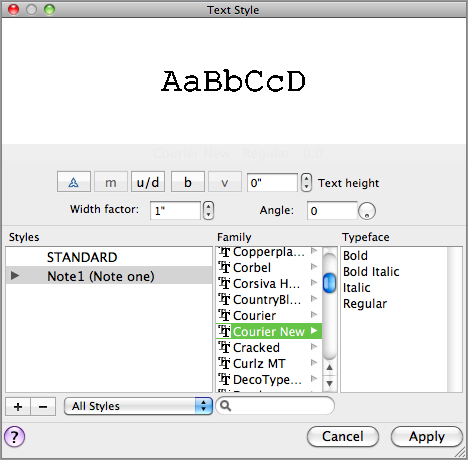
2. Click the + (plus) button at the bottom left of the dialog to add a new style.
3. Type Note1 for the name of your new style.
4. In the Family panel that is in the center of the dialog, scroll until you find the Courier New TrueType font. The Filter List input box can be helpful in reducing the number of fonts listed. Enter the first few letters of a font in the Filter List input box and select the font to use. Click the X button in the input box to clear your filter text string.
5. Click the Annotative button. When you select this button, notice that the Paper Text Height input box has now replaced the Text Height input box and the Note1 name now has an Annotative symbol in front of it.
6. In the Paper Text Height input box, enter 0.1 and press Enter. You’ll see your input change to 1⁄8 ˝ if you are using the architectural unit style. Metric users should enter 0.15.
7. Right-click the Note1 style and select Set Current.
8. Click the Apply button and then click Close.
The Annotative option you turned on in step 5 is an important feature for keeping your text at the proper size for your drawing scale. You’ll see how it works firsthand in the following section’s exercises.
Making a Style the Default
Once you’ve created a style, it becomes your default style. You can modify this by selecting it from the Text Style pop-up menu in the Properties Inspector palette while no object is selected.
Setting the Annotation Scale and Adding Text
You’ve got a text style set up and ready to use. Now you’ll add some text to your unit plan. Before you begin, you should determine a drawing scale. This is important because, with the Annotative feature turned on, AutoCAD needs to know the drawing scale in order to set the size of the text. Follow these steps:
1. In the right side of the status bar, click the Annotation Scale pop-up menu.
2. Select ¼˝ = 1´-0˝. Metric users, select 1:100.
You’ve just set the drawing scale for Model Space. This isn’t a permanent setting; you can change it at any time, as you’ll see later. The settings you used for the annotation scale are somewhat arbitrary for the purposes of demonstrating the Annotative Scale feature.
Finally, you can begin to add text:
1. Turn off the Object Snap button in the status bar.
2. Click the top icon in the Tool Sets palette. This icon will expand to show all available palettes. Click Annotation.
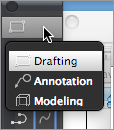
3. Click the Multiline Text icon in the Tool Sets palette. You can also type MT↵. You see a prompt that tells you the current text style and height:
Current text style: "Note1" Text height: 6"
Annotative: Yes
Specify first corner:
4. Click the first point indicated in the top image in Figure 9-1 to start the text boundary window. This boundary window indicates the area in which to place the text. Notice the arrow near the bottom of the window: It indicates the direction of the text flow. You don’t have to be too precise about where you select the points for the boundary because you can adjust the location and size later.
5. At the Specify opposite corner or [Height/Justify/Line spacing/Rotation/Style/Width/Columns]: prompt, click the second point indicated in the top image in Figure 9-1. The Text Editor visor appears, with the text editor superimposed over the area you just selected (Figure 9-3).
6. Click the text editor and type Entry. As you type, the word appears in the text editor just as it will appear in your drawing.
7. Press ↵ to advance one line; then enter 6´ by 7´.
Figure 9-3:The text editor visor floats over the selected area.

8. Press ↵ to advance another line, and enter [182 cm by 213 cm].
9. Press ↵ again to advance another line, and enter carpet floor.
10. Click Save in the Text Editor visor. The text appears in the drawing just as it did in the text editor. (See the bottom image in Figure 9-1.)
After you’ve added text, if the text doesn’t quite fit in the area you’ve indicated, you can make adjustments to the text boundary. Click the text to expose the text boundary, including the boundary grips. Then click and drag the grips to resize the boundary. AutoCAD’s word-wrap feature automatically adjusts the text formatting to fit the text boundary.
You may have noticed that the Text Editor visor and text editor work like many other text editors; if you make a typing error, you can highlight the error and retype the letter or word. You can perform other word processing functions too, such as using search and replace, importing text, and changing fonts.
You also saw that the text editor shows how your text will appear in the location you selected using the text boundary. If your view of the drawing is such that the text is too small to be legible, the text editor enlarges the text so you can read it clearly. Likewise, if you’re zoomed in too closely to see the entire text, the text editor adjusts the text to enable you to see all of it.
Making Text Readable over Hatch Patterns
If text is included in a selection where a hatch pattern is to be placed, AutoCAD automatically avoids hatching over the text. If you add text over a hatched area, you can use the Background Mask option in the text editor shortcut menu to make the text more readable. Another option is to use the Add: Select Objects button in the Hatch Edit dialog box to add text to a hatch selection.
Exploring Text and Scale
Even though your text height is 0.1˝, or 0.15 cm, it appears at the appropriately enlarged size for the current scale. If the text were drawn to the size of 0.1˝, it would be very small and barely visible. However, the Annotative Scale feature makes the adjustment to your text size based on the Annotation Scale setting.
You can see firsthand how the Annotation Scale setting affects your text:
1. First, make sure the Annotative Visibility button is turned on in the status bar, or type ANNOALLVISIBLE↵ 1↵.
2. Click the Automatically Add Scales To Annotative Objects When the Scale Changes setting.
3. Select ½˝ = 1´-0˝ from the pop-out menu. Metric users should select 1:50. The text changes to the appropriate size for the selected scale.

4. Select the Add/Delete Scales icon from the Tool Sets palette. You can also choose Modify Annotative Object Scale Add/Delete Scales in the menu bar or type OBJECTSCALE↵.
5. At the Select annotative objects: prompt, select the text, and press ↵. You see the Annotation Object Scale List dialog box (Figure 9-4) listing the two annotation scales you have used for this drawing.
Figure 9-4:The Annotation Object Scale List dialog box

6. You can add additional scales to your text object by clicking the + (plus) button, which opens the Add Scales To Object dialog box (Figure 9-5).
Figure 9-5:The Add Scales To Object dialog box

7. Click OK and then click OK again at the Annotation Object Scale List dialog box.
Now test your settings by changing the Annotation Scale value back to the previous setting: In the status bar, click the Annotation Scale pop-up menu, and select ¼˝ = 1´-0˝. Metric users should select 1:100. The text changes back to its original size.
In steps 4 through 6, you added a new annotation scale to the text. This is necessary for the text to be aware of the new annotation scale you want to use. Each time you include a new scale for your drawing, you need to add an annotation scale to the text in your drawing.
If you prefer, you can turn on the Automatically Add Scale To Annotative Objects in the status bar, which does just what its name says. The keyboard entry for this setting is ANNOAUTOSCALE↵ 4↵. Once a scale is added, you can quickly change between scales by selecting a scale from the Annotation Scale pop-up menu.
Text and Scale in Legacy Drawings
AutoCAD for Mac offers the Annotative Scale feature to automate the scaling of text and other objects to their proper size based on the drawing’s annotation scale. But there is a good chance you’ll encounter drawings that were created before the Annotative Scale feature was available. For that reason, you should have a basic understanding of scale factors as they apply to text.
As you know by now, AutoCAD lets you draw at full scale; that is, you can represent distances as values equivalent to the actual size of the object. When you later print the drawing, you tell AutoCAD the scale at which you want to print and the program reduces the drawing accordingly. This gives you the freedom to enter measurements at full scale and not worry about converting them to various scales every time you enter a distance. Unfortunately, in earlier releases of AutoCAD, this feature created problems when users entered text and dimensions. You had to make the text height very large in order for it to be readable when scaled down.
To illustrate this point, imagine you’re drawing the Unit plan at full size on a very large sheet of paper. When you’re finished with this drawing, it will be reduced to a scale that enables it to fit on an 8.5˝--11˝ sheet of paper. So you have to make your text large to keep it legible after it’s reduced. If you want text to appear 1⁄8˝ high when the drawing is printed, you must convert it to a considerably larger size when you draw it. To do this, you multiply the desired height of the final printed text by a scale conversion factor. (See Chapter 3 for more on scale conversion factors.)
For example, if your drawing is at a 1⁄8˝ = 1´-0˝ scale, you multiply the desired text height, 1⁄8˝, by the scale conversion factor of 96 to get a height of 12˝. This is the height you must make your text to get 1⁄8˝-high text in the final print.
With AutoCAD for Mac, you don’t have to work through the math to get the right text size for your drawing. But if you encounter a drawing that was created in an earlier release of AutoCAD and you notice that the text size is very large, you’ll know why.
So far, you’ve only used a single multiline text object. However, if you have many notes distributed throughout a drawing, you’ll need to add an annotation scale to all of them before they can automatically adjust themselves to the different scales you’ll use with your drawing. If you have Automatically Add Scale To Annotative Objects turned on in the status bar, this happens automatically. Otherwise, you’ll have to add the scales to each annotative object. This is easy to do because you have the option to select as many objects as you need when adding annotation scales.
Understanding the Text Style Dialog Box Options
You’ve just taken nearly all the steps you’ll need to know to add text to any drawing. Now let’s take a step back and look more closely at some of the finer points of adding text, starting with text styles. The following sections give you more detailed information about the text style settings in the Text Style dialog box (Figure 9-6) you saw in the early part of this chapter. They explain those settings and their purposes. Some of them, such as Width Factor, can be quite useful. Others, such as the Backwards and Vertical options, are rarely used. Take a moment to study these settings to become familiar with what is available and make a mental note of these items for future reference.
Figure 9-6:The Text Style dialog box
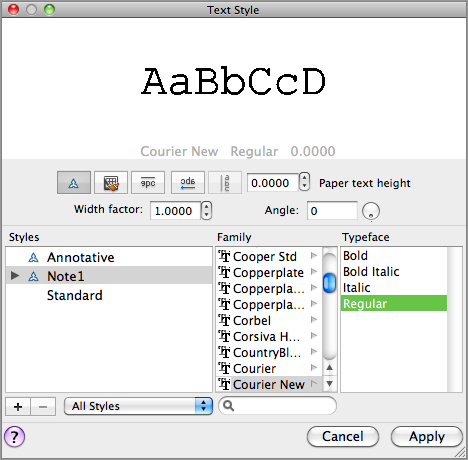
Effects
The Effects group offers settings relating to text size, scale, and orientation.
Annotative Causes the text size to automatically adjust to the current annotation scale setting.
Match Text Orientation To Layout Causes the text orientation to match the orientation of a layout view. This option is available only when the Annotative option is on.
Upside Down Displays text upside down.
Backwards Displays text backward.
Vertical Displays text in a vertical column.
Text Height/Paper Text Height Lets you enter a font size. With the Annotative option turned off, this option is named Text Height and will set the absolute height of the text. With the Annotative group turned on, it shows Paper Text Height and will set the height of the text when printed. A 0 height has special meaning when you use the Text command to enter text, as described later in this chapter, or when using the text style with a dimension style.
Width Factor Adjusts the width and spacing of the characters in the text. A value of 1 keeps the text at its normal width. Values greater than 1 expand the text, and values less than 1 compress the text.

Oblique Angle Skews the text at an angle. When this option is set to a value greater than 0, the text appears italicized. A value of less than 0 (-12, for example) causes the text to lean to the left.

Styles
In the Styles list box you’ll see a list showing the current style. This list also contains other styles that may be present in the drawing. The pop-up menu below the Styles list box lets you control whether all styles are listed or just those that are being used in the drawing. In addition, when you right-click on a style, you have the Set Current, Rename, and Delete options. You can also click and then click again to rename the style.
Set Current/New/Delete
The + (plus) button lets you create a new text style. Right-clicking the style name will give you the Set Current option, which makes the selected style the current one. You can also double-click the leftmost portion of the style in the list to set it to current—as indicated by a triangle. The – (minus) button lets you delete the selected style. You can also select Delete from the right-click option.
The Delete option isn’t available for the Standard style.
Font
In the Font group, you have the following options:
Style Displays the list of styles that are in the drawing.
Family Lets you select a font from a list of available fonts. The list is derived from the font resources available to the Mac OS plus the standard AutoCAD fonts.
Typeface Offers variations of a font, such as italic or bold, when they’re available.
When an AutoCAD font (SHX) file is selected, the Typeface option will be replaced with the Asian set option. This is applicable to Asian fonts.
Renaming a Text Style or Other Named Object
If you need to rename a text style or other named object in AutoCAD, you can do so using the Rename command. Choose Format Rename from the menu bar or enter REN↵ at the Command prompt to open the Rename dialog box. In the Named Objects list box to the left, choose Text Styles. Click the name of the style you want to change from the Items list on the right, click and click again to change the name, and then click OK.
Exploring Text Formatting in AutoCAD
You’ve seen how you can set up a style and make scale adjustments. AutoCAD also offers a wide range of text-formatting options that are typical of most word processing programs. You can control fonts, text height, justification, line spacing, and width. You can even include special characters such as degree symbols or stacked fractions. With these additional formatting tools, you can make adjustments to the text style with which you started.
Adjusting the Text Height and Font
To get some firsthand experience using the text-formatting tools in AutoCAD, try the following exercise. You’ll create multiline text again, but this time you’ll get to try out some of its other features.
In this exercise, you’ll see how you can adjust the size and font of text in the editor:
1. Pan your view so the kitchen is just at the top of the drawing, as shown in the first image in Figure 9-7.
2. In the status bar, set the Annotation Scale setting back to ¼˝ = 1´-0˝ (1:100 for metric users).
3. Click the Multiline Text icon on the Tool Sets palette, and then specify a text boundary window, as shown in the first image in Figure 9-7.
4. In the text editor, type the following:
Living Room
14´-0˝ by 16´-5˝ [427 cm by 500 cm]
Make sure you press ↵ after Living Room, but make the rest of the text a continuous string. As you type, the words wrap. AutoCAD uses word wrap to fit the text inside the text boundary area.
5. Highlight the text 14´-0˝ by 16´-5˝ [427 cm by 500 cm] as you would in any word processor.
6. In the Text Editor visor, click in the Text Height text box and enter 3. Metric users, enter 2.34. The highlighted text changes to a smaller size.
7. Highlight the words Living Room.
Figure 9-7:Placing the text boundary window for the living room label and the final label

8. Click the disclosure triangle on the right side of the Text Editor visor, and click the Font pop-up menu to display a list of font options.

9. Scroll the list until you find Arial, and select it. The text in the Text Editor visor changes to reflect the new font.
10. With the words Living Room still highlighted, click the Underline button.
11. Click Save in the Text Editor visor. The label appears in the area you indicated in step 3 (see the bottom image in Figure 9-7).
12. To see how you can go back to the Text Editor visor, double-click the text. The Text Editor visor and text editor appear, enabling you to change the text.
13. Click Save in the Text Editor visor.
While using the Multiline Text tool, you may have noticed the Specify opposite corner or [Height/Justify/Line spacing/Rotation/Style/Width/Columns]: prompt immediately after you picked the first point of the text boundary. You can use any of these options to make on-the-fly modifications to the height, justification, line spacing, rotation style, or width of the multiline text.
For example, after clicking the first point for the text boundary, you can type R↵ and then specify a rotation angle for the text window, either graphically with a rubber-banding line or by entering an angle value. After you’ve entered a rotation angle, you can resume selecting the text boundary.
Understanding Text Formatting with the Text Editor Visor
You’ve just experimented with a few of the text formatting features of the Text Editor visor. A variety of additional formatting tools are available. Table 9-1 describes their uses. They’re fairly straightforward, and if you’ve used other word processing programs, you should find them easy to use. Most are common to the majority of word processors, although a few—such as Symbol, Background Mask, and Oblique Angle—are unique to AutoCAD. Look at Table 9-1 and see if there are any tools you think you’ll find useful.
Table 9-1: Text-formatting tools
| Tool | Use |
| Text Style | Select a text style. |
| Text Height | Set the paper text height of text currently being entered or edited. |
| Bold/Italic/Underline/Overline | Select text, and then select one of these options to add bold, italic, underline, or overline to the text. |
| Color | Select text, and then choose a color from this pop-up menu. |
| Font | Select a font different from the font for the current text style. |
| Background Mask | Available through the right-click menu, this tool gives you control over the background mask feature, which places a background behind text to make it more readable when placed over hatch patterns. |
| Change Case | Available through the right-click menu, changes the case of text. |
| Paragraph | Available through the right-click menu, displays the Paragraph dialog box. Lets you set up paragraph formatting, including tabs, indents, and line and paragraph spacing. You can also set line spacing in the Properties Inspector palette for an Mtext object. (See “Setting Indents and Tabs” later in this chapter.) |
| Bullets And Lists | Available through the right-click menu; select a text list, click this tool, and then select Lettered, Numbered, or Bulleted to add letters, numbers, or bullets to the list. |
| Default/Left/Center/Right /Justify/Distribute | Click the appropriate tool to align the text to the left, center, or right side of the text boundary. Justify adds space between words to force left and right alignment. Distribute adds space between letters to force left and right alignment. |
| Columns | Available through the right-click menu, indicates the number of columns and how the columns are set up. |
| Symbol | Place the cursor at a location for the symbol, and then click the Symbol tool to find and add a symbol. (See Figure 9-8, later in this chapter, for the available symbols.) |
| Insert Field | Click to open the Insert Field dialog box where you can add a text field. See “Adding Formulas to Cells,” in Chapter 10, for more about fields. |
| Character Set | Available through the right-click menu, Character Set offers foreign-language characters such as Cyrillic or Greek, for example. |
Adding Symbols and Special Characters
The Text Editor visor also offers a tool called Insert Symbols. This tool lets you add special symbols common to technical drawing and drafting. Figure 9-8 shows the symbols that are offered in the Symbol tool in the form of a pop-up menu.
Figure 9-8:Symbols offered by the Symbol option. (See Symbol in Table 9-1 for information about how to use these symbols.)
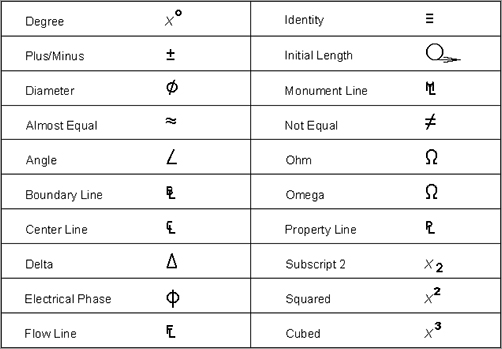
At the bottom of the Symbol pop-up menu is an option called Other. By clicking the Other option, you open the Characters dialog box (Figure 9-9). Characters such as the trademark (™) and copyright (©) symbols are often available in the fonts offered in the Characters dialog box. The contents of the Symbol pop-up menu depend on the font currently selected.
Figure 9-9:The Characters dialog box

Finally, in case your application requires music, math, astronomy, Greek, or other symbols, AutoCAD offers a set of fonts with special symbols. You can set up text styles with these fonts or call them up directly from the Text Editor visor’s Font pop-up menu.
Text Justification and Osnaps
You may have noticed that multiline text has three center justification options: Top Center (TC), Middle Center (MC), and Bottom Center (BC). All three of these options have the same effect on the text’s appearance, but they each have a different effect on how osnaps act on the text. Figure 9-10 shows where the osnap point occurs on a text boundary depending on which justification option is selected. A multiline text object has only one insertion point on its boundary, which you can access with the Insertion osnap.
Figure 9-10:The location of the Insertion osnap point on a text boundary, based on its justification setting

The osnap point also appears as an extra grip point on the text boundary when you click the text. If you click the text you just entered, you’ll see that a grip point now appears at the top center of the text boundary.
Knowing where the osnap points occur can be helpful when you want to align the text with other objects in your drawing. In most cases, you can use the grips to align your text boundary, but the Top Center and Middle Center justification options enable you to use the center and middle portions of your text to align the text with other objects.
Setting Indents and Tabs
You should also know about the indent and tab features of the text editor. You may have noticed the ruler at the top of the text editor. Figure 9-11 shows that ruler, including tab and indent markers.
The indent markers let you control the indention of the first line and the rest of the paragraph. The tab markers give you control over tab spacing. For new text, the tab markers don’t appear until you add them by clicking the ruler. The following exercises will demonstrate the use of these markers more clearly.
Figure 9-11:The ruler at the top of the text editor lets you quickly set tabs and indents for text.
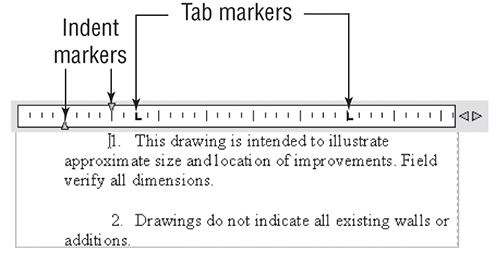
Start by practicing with the indent markers:
1. Save the Unit drawing, and then open the indent.dwg file, which can be obtained from this book’s companion website. This file contains some text you’ll experiment with.
2. Double-click the text at the top of the drawing to open the Text Editor visor.
3. Press F-A to highlight all the text in the text editor. This is necessary to indicate the text group to be affected by your indent settings.
4. Click and drag the top indent marker two spaces to the right. The indent of the first line moves with the marker. Notice that the text at the first tab remains at its starting location.

5. Click and drag the bottom indent marker two spaces to the left. The rest of the paragraph moves with the marker.
6. Click Save in the Text Editor visor to exit.
Here you see how you can control the indents of the selected text with the indent markers. You can set paragraphs of a single multiline text object differently, giving you a wide range of indent-formatting possibilities. Just select the text you want to set, and then adjust the indent markers.
Now try the tab markers. For this exercise, you’ll try the text-import feature to import a tab-delimited text file:
1. Click the Multiline Text icon on the Tool Sets palette.
2. For the first corner of the text boundary, click the upper-left corner of the large rectangle in the drawing, just below the paragraph.
3. For the opposite corner of the text boundary, click the lower-right corner of the rectangle.
4. Right-click in the text editor, and select Import Text.
5. In the Select File dialog box, locate and select the tabtest.txt file and then click Open. The contents of the tabtest.txt file are displayed in the text editor.
This file contains tabs to align the columns of information. You can adjust those tabs in the text editor, as you’ll see in the next set of steps.
Now use the tab markers to adjust the tab spacing of the columns of text:
1. Press F-A to select all the text.
2. Click the ruler at a point that is at the 12th mark from the left (that’s three of the taller tick marks in the ruler). An L-shaped marker appears, and the first tab column of text moves to this position.

3. Click the ruler again at the 20th mark. The second tab column aligns to this position.

4. Continue to click the ruler to add more tab markers so the text looks similar to Figure 9-12. Don’t worry about being exact; this is just for practice. After you’ve placed a marker, you can click and drag it to make adjustments.
Figure 9-12:Add tab markers so your text looks similar to this figure.

5. Click Save in the Text Editor visor. The text appears in the drawing as a door schedule.
Here you saw how you can create a table or a schedule from an imported text file. You can also create a schedule from scratch by composing it directly in the text editor of the Multiline Text (Mtext) command. AutoCAD also offers the Table feature, which is specifically designed for creating tables (see Chapter 10). Still, this example offers a way to demonstrate the tab feature of Multiline Text, and you may encounter a file in which a table is formatted in the way described here.
In addition to using the indent and tab markers on the ruler, you can control indents and tabs through the Paragraph dialog box. Do the following to get a firsthand look:
1. Double-click the text at the top of the indent.dwg drawing (the one you edited in the first part of this section), and then press F-A to select all the text.
2. Right-click the ruler above the text editor, and select Paragraph to open the Paragraph dialog box (Figure 9-13). The Paragraph dialog box also lets you set other paragraph options, such as alignment, spacing between paragraphs, and line spacing in the paragraph.
Figure 9-13:The Paragraph dialog box

3. In the Left Indent section, change the value of the First Line input box to 1.5 and the Hanging input box to 2.2.
4. Double-click the tab position input box in the upper-left corner, just below the row of tab symbols in the Tab group. Enter 2.2, and click the Add button.
5. Click OK. The text now appears with the text indented from the numbers.

6. Click Save in the Text Editor visor. The text in the drawing is now formatted as it appeared in the text editor.
7. Exit but do not save the indent.dwg file.
In this exercise, you used the Paragraph dialog box to set the paragraph indent and the first tab marker to be the same value. This causes the text portion of the list to be aligned at a distance of 2.2 drawing units from the left text boundary, leaving the list number extended farther to the left. This gives the list a more professional appearance.
The Paragraph dialog box gives you fine control over the formatting of your text. It lets you delete tabs by highlighting them in the list and clicking the Remove button. You can also add tabs at specific distances from the left margin of the text boundary by entering new tab locations in the tab input box and clicking the Add button.
You specify distances in drawing units. If your drawing is set up to use architectural units, for example, you can enter values in feet and inches or just inches. In the First Line and Hanging input boxes, you enter a numeric value for paragraph indents. As you’ve just seen, you can use the First Line and Hanging input boxes to create a numbered list by setting the Hanging input box value to be the same as the first tab stop position.
You’ve already seen a few of the fonts available in AutoCAD. Chances are you’re familiar with the TrueType fonts available in the Mac OS. You have some additional AutoCAD fonts from which to choose. You may want to stick with the AutoCAD fonts for all but your presentation drawings because other fonts can consume more memory.
Figure 9-14 shows the basic AutoCAD text fonts. The Romans font is perhaps the most widely used because it offers a reasonable appearance while consuming little memory.
Figure 9-14:Some of the standard AutoCAD text fonts
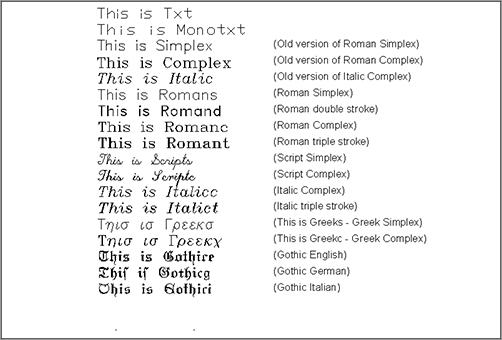
Importing Text Files
With multiline text objects, AutoCAD enables you to import ASCII text or Rich Text format (RTF) files. RTF files can be exported from Microsoft Word and most other word processing programs and retain most of their formatting in AutoCAD. Here’s how you import text files:
1. With the Multiline Text editor open, right-click in the text area, and choose Import Text.
2. In the Select File dialog box, locate a valid text file. It must be a file in either a raw text (ASCII) format (.txt) or RTF (.rtf). RTF files can store formatting information such as boldface and varying point sizes.
3. After you’ve highlighted the file you want, double-click it or click Open. The text appears in the text editor.
4. Click Save in the Text Editor visor, and the text appears in your drawing.
In the following sections, you’ll work with some of the AutoCAD fonts. You can see samples of all the fonts, including TrueType fonts, in the preview window of the Text Style dialog box. If you use a word processor, you’re probably familiar with at least some of the TrueType fonts available in the Mac OS and AutoCAD.
The Textfill System Variable
Unlike the standard sticklike AutoCAD fonts, TrueType and PostScript fonts have filled areas. These filled areas take more time to generate, so if you use these fonts for a lot of text, your redraw and regen times will increase. To help reduce redraw and regen times, you can set AutoCAD to display and plot these fonts as outline fonts while still printing them as solid fonts.
To change this setting, type TEXTFILL↵, and then type 0↵. Doing so turns off text fill for PostScript and TrueType fonts. (This is the same as setting the Textfill system variable to 0.)
Adding Simple Single-Line Text Objects
You might find that you’re entering a lot of single words or simple labels that don’t require all the bells and whistles of the Multiline Text editor. AutoCAD offers the single-line text object, which is simpler to use and can speed text entry if you’re adding only small pieces of text.
Continue the tutorial on the Unit.dwg file by trying the following exercise:
1. Adjust your view so you see the part of the drawing shown in Figure 9-15.
Figure 9-15:Adjust your view to look like this.

2. Make sure Note1 is the current text style and then choose Draw Text Single Line Text from the menu bar, or enter DT↵.
3. At the Specify start point of text or [Justify/Style]: prompt, pick the starting point for the text you’re about to enter, just below the kitchen at coordinate 17´-2˝,22´-5˝ (490,664 for metric users). Note that the prompt offers the Justify and Style options.
4. At the Specify rotation angle of text <0>: prompt, press ↵ to accept the default, 0. You can specify any angle you like at this prompt (for example, if you want your text aligned with a rotated object). You see a text I-beam cursor at the point you picked in step 3.
5. Type Kitchenette. As you type, the word appears directly in the drawing.
Pasting Text from Other Sources
You can cut and paste text from the Clipboard into the cursor location by using the F-V keyboard shortcut or by right-clicking in the drawing area to access the shortcut menu.
6. You can press ↵ to move the cursor down to start a new line below the one you just entered.
7. This time, you want to label the bathroom. Pick a point to the right of the door swing; you can approximate the location since you can always adjust the text location later. The text cursor moves to that point.
8. Type Bathroom↵. Figure 9-16 shows how your drawing should look now.
9. Press ↵ again to exit the Text command.
Figure 9-16:Adding simple labels to the kitchen and bath by using the Text command

Continuing Where You Left Off
If for some reason you need to stop entering single-line text objects to do something else in AutoCAD, you can continue the text where you left off by starting the Text command and then pressing ↵ at the Specify start point of text or [Justify/Style]: prompt. The text continues immediately below the last line of text entered.
Here you were able to add two single lines of text in different parts of your drawing fairly quickly. The Text command uses the current default text style settings.
To edit single-line text, you can double-click the text. The text is highlighted, and you can begin typing to replace it all, or you can click a location in the text to make single word or character changes.
This is the end of the tutorial section of this chapter. The rest of this chapter offers additional information about text.
Justifying Single-Line Text Objects
Justifying single-line text objects is slightly different from justifying multiline text. For example, if you change the justification setting to Center, the text moves so the center is placed at the text-insertion point. In other words, the insertion point stays in place while the text location adjusts to the new justification setting. Figure 9-17 shows the relationship between single-line text and the insertion point based on different justification settings.
Figure 9-17:Text inserted using the various justification options

To set the justification of text as you enter it, you must enter J↵ at the Specify start point of text or [Justify/Style]: prompt after issuing the Text command. You can also change the current default style by entering S↵ and then the name of the style at the Specify start point of text or [Justify/Style]: prompt.
After you’ve issued Text’s Justify option, you get the following prompt:
Enter an option
[Align/Fit/Center/Middle/Right/TL/TC/TR/ML/MC/MR/BL/BC/BR]:
Here are descriptions of each of the options.
Align and Fit With the Align and Fit justification options, you must specify a dimension in which the text is to fit. For example, suppose you want the word Refrigerator to fit in the 26˝-wide box representing the refrigerator. You can use either the Fit or the Align option to accomplish this. With Fit, AutoCAD prompts you to select start and end points and then stretches or compresses the letters to fit within the two points you specify. You use this option when the text must be a consistent height throughout the drawing and you don’t care about distorting the font. Align works like Fit, but instead of maintaining the current text style height, the Align option adjusts the text height to keep it proportional to the text width without distorting the font. Use this option when it’s important to maintain the font’s shape and proportion. Figure 9-18 demonstrates how Fit and Align work.
Figure 9-18:The word Refrigerator as it appears normally and with the Fit and Align options selected
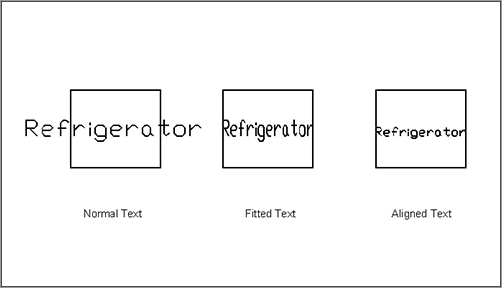
Center Centers the text on the start point with the baseline on the start point.
Middle Centers the text on the start point with the baseline slightly below the start point.
Right Justifies the text to the right of the start point with the baseline on the start point.
TL, TC, and TR TL, TC, and TR stand for Top Left, Top Center, and Top Right. When you use these justification styles, the text appears entirely below the start point, justified left, center, or right, depending on which option you choose.
ML, MC, and MR ML, MC, and MR stand for Middle Left, Middle Center, and Middle Right. These styles are similar to TL, TC, and TR except that the start point determines a location midway between the baseline and the top of the lowercase letters of the text.
BL, BC, and BR BL, BC, and BR stand for Bottom Left, Bottom Center, and Bottom Right. These styles too are similar to TL, TC, and TR, but here the start point determines the bottommost location of the letters of the text (the bottom of letters that have descenders, such as p, q, and g).
Keeping Text from Mirroring
At times, you’ll want to mirror a group of objects that contain some text. This operation causes the mirrored text to appear backward. You can change a setting in AutoCAD to make the text read normally even when it’s mirrored:
1. At the Command prompt, enter MIRRTEXT↵.
2. At the Enter new value for MIRRTEXT <1>: prompt, enter 0↵.
Now any mirrored text that isn’t in a block will read normally. The text’s position, however, will still be mirrored, as shown in the following example. Mirrtext is set to 0 by default.

Using Special Characters with Single-Line Text Objects
Just as with multiline text, you can add a limited set of special characters to single-line text objects. For example, you can place the degree symbol (°) after a number, or you can underscore (underline) text. To accomplish this, you use double percent signs (%%) in conjunction with a special code. For example, to underscore text, you enclose that text with %% followed by the letter u, which is the underscore code. So to create the text, “This is underscored text,” you enter the following at the prompt:
This is %%uunderscored%%u text.
Overscoring (putting a line above the text) operates in the same manner. To insert codes for symbols, you place the codes in the correct positions for the symbols they represent. For example, to enter 100.5°, you type 100.5%%d. Table 9-2 shows some other examples of special-character codes.
Table 9-2: Special-character codes
| Code | Result |
| %%o | Toggles overscore on and off. |
| %%u | Toggles underscore on and off. |
| %%c | Places a diameter symbol (ø) where the code occurs. |
| %%d | Places a degree sign (°) where the code occurs. |
| %%p | Places a plus/minus sign (±)where the code occurs. |
| %%% | Forces a single percent sign (%). This is useful when you want a double percent sign to appear or when you want a percent sign in conjunction with another code. |
| %%nnn | Allows the use of extended characters or Unicode characters when these characters are available for a given font. nnn is the three-digit value representing the ASCII extended character code. |
Using the Characters Dialog Box to Add Special Characters
You can add special characters to a single line of text in the same way you add special characters to multiline text. You may recall that to access special characters, you use the Characters dialog box.
The easiest way to accomplish this is to activate the Characters dialog box from the Mac OS and have it appear in the Mac OS menu bar.
1. Open System Preferences
2. On the Mac OS menu bar, click Edit Special Characters.
Using the Check Spelling Feature
Although AutoCAD is primarily a drawing program, you’ll find that some of your drawings contain more text than graphics. Autodesk recognizes this fact and has been including a spelling checker since AutoCAD Release 14. If you’ve ever used the spelling checker in a typical word processor, the AutoCAD spelling checker’s operation will be familiar to you. These steps show you how it works:
1. Click the Check Spelling icon in the Annotate toolset on the Tool Sets palette. You can also type SP↵. The Check Spelling dialog box appears (Figure 9-19).
2. You can click the Start button to check the spelling in the entire drawing. Or, if you prefer, you can be more selective of the text you want to check by choosing an option from the Where To Check pop-up menu. You can select a mixture of multiline and single-line text as well as dimension text, attributes, and text in Xrefs.
When the spelling checker finds a word it doesn’t recognize, the Check Spelling dialog box shows you the word along with a suggested spelling. If the spelling checker finds more than one spelling, a list of suggested alternate words appears below the input box. You can then highlight the desired replacement and click the Change button to change the misspelled word, or you can click Change All to change all occurrences of the word in the selected text. If the suggested word is inappropriate, choose another word from the replacement list (if any) or enter your own spelling in the Suggestions text box. Then click Change or Change All.
Figure 9-19:The Check Spelling dialog

Here is a list of the options available in the Check Spelling dialog box:
Add Word Adds the word in question to the current dictionary.
Ignore Once Skips the word.
Ignore All Skips all occurrences of the word in the text being checked.
Change Changes the word in question to the word you’ve selected from (or entered into) the Suggestions text box.
Change All Changes all occurrences of the current word when there are multiple instances of the misspelling.
Show Options Clicking the Show Options disclosure triangle will expand and show the check spelling options.
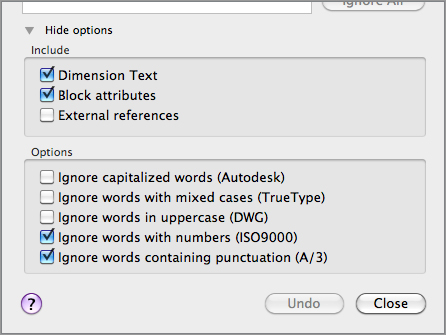
The Check Spelling feature includes types of notations that are likely to be found in technical drawings. It also checks the spelling of text that is included in block definitions.
One of the most time-consuming tasks in drafting is replacing text that appears repeatedly throughout a drawing. Fortunately, you have a Find And Replace tool to help simplify this task. AutoCAD’s Find And Replace works like any other find-and-replace tool in a word processing program. Here’s how it works:
1. Click the Find Text icon in the Tool Sets palette. You can also type FIND↵.
2. Enter the text you want to locate in the Find And Replace dialog box (Figure 9-20), and then click the Find button.
Figure 9-20:Using Find And Replace

3. Enter the replacement text in the Replace With text box.
4. When you’ve made certain that this is the text you want to change, click Replace. If you want to replace all occurrences of the text string in the drawing, click Replace All.
5. If you want to skip over the found text, click the Find button to locate the next instance of the text string in your drawing. If the text string is not found, AutoCAD returns to your original view.
Making Substitutions for Missing Fonts
When text styles are created, the associated fonts don’t become part of the drawing file. Instead, AutoCAD loads the needed font file at the same time the drawing is loaded. If a text style in a drawing requires a particular font, AutoCAD looks for the font in the AutoCAD search path; if the font is there, it’s loaded. Usually this isn’t a problem if the drawing file uses the standard fonts that come with AutoCAD or the operating system. But occasionally, you’ll encounter a file that uses a custom font.
In earlier releases of AutoCAD, you saw an error message when you attempted to open such a file. This missing-font message often sent new AutoCAD users into a panic.
Fortunately, AutoCAD automatically substitutes an existing font for the missing font in a drawing. By default, AutoCAD substitutes the simplex.shx font, but you can specify another font by using the Fontalt system variable. Type FONTALT↵ at the Command prompt, and then enter the name of the font you want to use as the substitute.
You can also select an alternate font through the Application tab of the Application Preferences dialog box. Locate the Text Editor, Dictionary, And Font File Names item, and then click the symbol at the left. Locate the Alternate Font File item, and click the symbol at the left. The current alternate is listed. You can double-click the font name to select a different font through the Select Alternate Font dialog box.
Be aware that the text in your drawing will change in appearance, sometimes radically, when you use a substitute font. If the text in the drawing must retain its appearance, substitute a font that looks as similar to the original font as possible.
You can also limit your find-and-replace operation to a specific set of objects in your drawing by choosing Select Objects from the Where To Check pop-up menu.
When you click the Select Objects button, the Find And Replace dialog box closes temporarily to enable you to select a set of objects or a region of your drawing. Find And Replace then limits its search to those objects or the region you select.
You can further control the types of objects that Find And Replace looks for by clicking the disclosure triangle in the lower-left corner of the Find And Replace dialog box. The dialog box expands to show more options (Figure 9-21).
Figure 9-21:More extensive options for Find And Replace
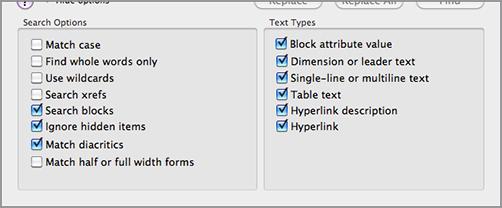
With this dialog box, you can refine your search by limiting it to blocks, dimension text, standard text, or hyperlink text. You can also specify whether to match the case and find whole words only.
Speeding Up AutoCAD with Qtext
If you need to edit a large drawing that contains a lot of text but you don’t need to edit the text, you can use the Qtext command to help accelerate redraws and regenerations when you’re working on the drawing. Qtext turns lines of text into rectangular boxes, saving AutoCAD from having to form every letter. This enables you to see the note locations so you don’t accidentally draw over them. To use it, enter QTEXT↵ at the Command prompt and enter On↵ or select the On option from the Dynamic Input display. Regenerate your drawing to see only the boundary boxes for all text objects.
Create Paragraph Columns
You can format Mtext into multiple columns. This can be useful for long lists or to create a newspaper column appearance for your text. Text formatted into columns will automatically flow between columns as you add or remove text.
To format text into columns, do the following:
1. Create the text using the Mtext command as usual.
2. Click and drag the double-headed arrow at the bottom of the text upward. As you do this, a second column appears.

3. If you want to create another column, click and drag the double-headed arrow below the second column upward.
4. To adjust the column width, click and drag the diamond icon that appears just to the right of the first column in the ruler. All the columns will adjust to the width of the first column.
Once you’ve set up your columns, click Save on the Text Editor visor. You can adjust the column width and spacing by using grips that appear when you click on the text.
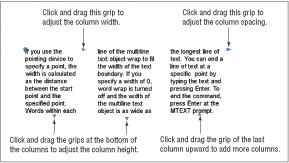
To adjust the column width of existing multiline text, click and drag the arrow grip above and to the right of the first column. To adjust the width between columns, click and drag the arrow grip in the above and to the right of the group of columns. The grips at the bottom of each column allow you to adjust the height of the columns.
You can manually set column features through the Column Settings dialog box. To open it, double-click on the multiline text and then right-click in the text editor and choose Columns Column Settings.
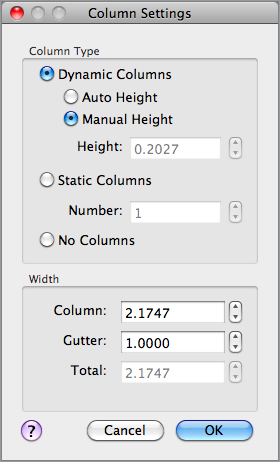
The Dynamic Columns option is the default for the Column Type group and it allows you to adjust the column size using grips.
Prepare a drawing for text. AutoCAD offers an extensive set of features for adding text to a drawing, but you need to do a little prep work before you dive in.
Master It Name two things you need to do to prepare a drawing for text.
Set the annotation scale and add text. Before you start to add text, you should set the annotation scale for your drawing. Once this is done, you can begin to add text.
Master It In a sentence or two, briefly describe the purpose of the annotation scale feature. Name the tool you use to add text to a drawing.
Explore text formatting in AutoCAD. Because text styles contain font and text-size settings, you can usually set up a text style and then begin to add text to your drawing. For those special cases where you need to vary text height and font or other text features, you can use the Text Editor visor of the text editor.
Master It What text formatting tool can you use to change text to boldface type?
Add simple single-line text objects. In many situations, you need only a single word or a short string of text. AutoCAD offers the single line text object for these instances.
Master It Describe the methods for starting the single-line text command.
Use the Check Spelling feature. It isn’t uncommon for a drawing to contain the equivalent of several pages of text, and the likelihood of having misspelled words can be high. AutoCAD offers the Check Spelling feature to help you keep your spelling under control.
Master It What option do you select in the Check Spelling dialog box when it finds a misspelled word and you want to accept the suggestion it offers?
Find and replace text. A common activity when editing technical drawings is finding and replacing a word throughout a drawing.
Master It True or false: The Find And Replace feature in AutoCAD works very differently than the find-and-replace feature in other programs.
